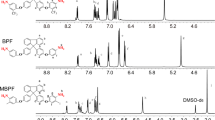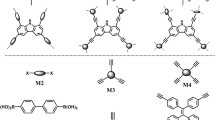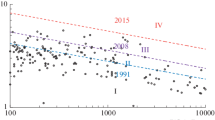Abstract
The design and development of highly permeable, selective and stable polymer membranes are great challenges in the gas separation industry. Herein, we constructed two intrinsic microporous polyimides (6FPCA and 6FMCA) derived from two isometric diamines (PCA and MCA), which were synthesized by palladium catalyzed C—N coupling reaction. The PCA and MCA diamines contain a hollow beaded structure of 2,2′-paracyclophane as a building block with a specified window size of 3.09 Å. The chemical structures of monomers, polyimides were confirmed by NMR, FTIR, and elementary analysis. 6FPCA and 6FMCA exhibit good solubility, excellent thermal stability, and mechanical properties. 6FPCA exhibits much larger microporosity (434 versus 120 m2·g−1), FFV (0.22 versus 0.15), d-spacing (6.9 versus 5.9 Å), and over 10 times higher permeability with a very little decrease in selectivity than the corresponding polyimide (6FpA) with a plane structure, which remarkably increased their separation performance from far below the 2008 Robeson Upper bounds to reach these limitations for O2/N2 and CO2/CH4. Additionally, the 6FPCA also demonstrates good plasticization resistance, moderate aging properties, and high CO2/CH4 mixed-gas separation performance. These results indicate that paracyclophane subunit can be successfully incorporated into polymers to enhance their ultra-microporosity and separation properties, which open a new avenue for developing high performance gas separation membranes with topological ultra-micropores.
Similar content being viewed by others
References
Sholl, D. S.; Lively, R. P. Seven chemical separations to change the world. Nature 2016, 532, 435–437.
Galizia, M.; Chi, W. S.; Smith, Z. P.; Merkel, T. C.; Baker, R. W.; Freeman, B. D. 50th Anniversary perspective: polymers and mixed matrix membranes for gas and vapor separation: a review and prospective opportunities. Macromolecules 2017, 50, 7809–7843.
Sandru, M.; Sandru, E. M.; Ingram, W. F.; Deng, J.; Stenstad, P. M.; Deng, L.; Spontak, R. J. An integrated materials approach to ultrapermeable and ultraselective CO2 polymer membranes. Science 2022, 376, 90–94.
Park, H. B.; Kamcev, J.; Robeson, L. M.; Elimelech, M.; Freeman, B. D. Maximizing the right stuff: the trade-off between membrane permeability and selectivity. Science 2017, 356, eaab0530.
Zhu, B., He, S., Yang, Y. et al. Boosting membrane carbon capture via multifaceted polyphenol-mediated soldering. Nat. Commun. 2013, 14, 167.
Zhu, B.; He, S.; Wu, Y.; Li, S.; Shao, L. One-step synthesis of structurally stable CO2-philic membranes with ultra-high PEO loading for enhanced carbon capture. Engineering 2022.
Robeson, L. M. The upper bound revisited. J. Membr. Sci. 2008, 320, 390–400.
Swaidan, R.; Ghanem, B.; Pinnau, I. Fine-tuned intrinsically ultramicroporous polymers redefine the permeability/selectivity upper bounds of membrane-based air and hydrogen separations. ACS Macro Lett. 2015, 4, 947–951.
Freeman, B. D. Basis of permeability/selectivity tradeoff relations in polymeric gas separation membranes. Macromolecules 1999, 32, 375–380.
Comesaña-Gándara, B.; Chen, J.; Bezzu, C. G.; Carta, M.; Rose, I.; Ferrari, M. C.; Esposito, E.; Fuoco, A.; Jansen, J. C.; McKeown, N. B. Redefining the Robeson upper bounds for CO2/CH4 and CO2/N2 separations using a series of ultrapermeable benzotriptycene-based polymers of intrinsic microporosity. Energy Environ. Sci. 2019, 12, 2733–2740.
Du, N.; Park, H. B.; Robertson, G. P.; Dal-Cin, M. M.; Visser, T.; Scoles, L.; Guiver, M. D. Polymer nanosieve membranes for CO2-capture applications. Nat. Mater. 2011, 10, 372–375.
Yin, Y.; Guiver, M. D. Microporous polymers: ultrapermeable membranes. Nat. Mater. 2017, 16, 880–881.
Guiver, M. D.; Lee, Y. M. Polymer rigidity improves microporous membranes. Science 2013, 339, 284–285.
Budd, P. M.; Ghanem, B. S.; Makhseed, S.; McKeown, N. B.; Msayib, K. J.; Tattershall, C. E. Polymers of intrinsic microporosity (PIMs): robust, solution-processable, organic nanoporous materials. Chem. Commun 2004, 230–231.
Budd, P. M.; McKeown, N. B.; Fritsch, D. Free volume and intrinsic microporosity in polymers. J. Mater. Chem. 2005, 15, 1977–1986.
Budd, P. M.; Msayib, K. J.; Tattershall, C. E.; Ghanem, B. S.; Reynolds, K. J.; McKeown, N. B.; Fritsch, D. Gas separation membranes from polymers of intrinsic microporosity. J. Membr. Sci. 2005, 251, 263–269.
Li, P.; Chung, T. S.; Paul, D. R. Gas sorption and permeation in PIM-1. J. Membr. Sci. 2013, 432, 50–57.
Ghanem, B. S.; McKeown, N. B.; Budd, P. M.; Selbie, J. D.; Fritsch, D. High-performance membranes from polyimides with intrinsic microporosity. Adv. Mater. 2008, 20, 2766–2771.
Bezzu, C. G.; Carta, M.; Tonkins, A.; Jansen, J. C.; Bernardo, P.; Bazzarelli, F.; McKeown, N. B. A spirobifluorene-based polymer of intrinsic microporosity with improved performance for gas separation. Adv. Mater. 2012, 24, 5930–5933.
Carta, M.; Malpass-Evans, R.; Croad, M.; Rogan, Y.; Jansen, J. C.; Bernardo, P.; Bazzarelli, F.; McKeown, N. B. An efficient polymer molecular sieve for membrane gas separations. Science 2013, 339, 303–307.
Carta, M.; Croad, M.; Malpass-Evans, R.; Jansen, J. C.; Bernardo, P.; Clarizia, G.; Friess, K.; Lanc, M.; McKeown, N. B. Triptycene induced enhancement of membrane gas selectivity for microporous Troger’s base polymers. Adv. Mater. 2014, 26, 3526–3531.
Rose, I.; Bezzu, C. G.; Carta, M.; Comesana-Gandara, B.; Lasseuguette, E.; Ferrari, M. C.; Bernardo, P.; Clarizia, G.; Fuoco, A.; Jansen, J. C.; Hart, K. E.; Liyana-Arachchi, T. P.; Colina, C. M.; McKeown, N. B. Polymer ultrapermeability from the inefficient packing of 2D chains. Nat. Mater. 2017, 16, 932–937.
Lai, H. W. H.; Benedetti, F. M.; Ahn, J. M.; Robinson, A. M.; Wang, Y.; Pinnau, I.; Smith, Z. P.; Xia, Y. Hydrocarbon ladder polymers with ultrahigh permselectivity for membrane gas separations. Science 2022, 375, 1390–1392.
Budd, P. M.; Elabas, E. S.; Ghanem, B. S.; Makhseed, S.; McKeown, N. B.; Msayib, K. J.; Tattershall, C. E.; Wang, D. Solution-processed, organophilic membrane derived from a polymer of intrinsic microporosity. Adv. Mater. 2004, 16, 456–459.
Yi, S.; Ghanem, B.; Liu, Y.; Pinnau, I.; Koros, W. J. Ultraselective glassy polymer membranes with unprecedented performance for energy-efficient sour gas separation. Sci. Adv. 2019, 5, eaaw5459.
Ma, X.; Lai, H. W. H.; Wang, Y.; Alhazmi, A.; Xia, Y.; Pinnau, I. Facile synthesis and study of microporous catalytic arene-norbornene annulation-Tröger’s base ladder polymers for membrane air separation. ACS Macro Lett. 2020, 9, 680–685.
Ma, X. H.; Abdulhamid, M. A.; Pinnau, I. Design and synthesis of polyimides based on carbocyclic pseudo-Troger’s base-derived dianhydrides for membrane gas separation applications. Macromolecules 2017, 50, 5850–5857.
Ma, X. H.; Ghanem, B.; Salinas, O.; Litwiller, E.; Pinnau, I. Synthesis and effect of physical aging on gas transport properties of a microporous polyimide derived from a novel spirobifluorene-based dianhydride. ACS Macro Lett. 2015, 4, 231–235.
Ma, X. H.; Salinas, O.; Litwiller, E.; Pinnau, I. Novel spirobifluorene-and dibromospirobifluorene-based polyimides of intrinsic microporosity for gas separation applications. Macromolecules 2013, 46, 9618–9624.
Ghanem, B. S.; Swaidan, R.; Litwiller, E.; Pinnau, I. Ultra-Microporous triptycene-based polyimide membranes for highperformance gas separation. Adv. Mater. 2014, 26, 3688–3692.
Ghanem, B. S.; Swaidan, R.; Ma, X.; Litwiller, E.; Pinnau, I. Energy-efficient hydrogen separation by AB-type ladder-polymer molecular sieves. Adv. Mater. 2014, 26, 6696–6700.
Bezzu, C. G.; Fuoco, A.; Esposito, E.; Monteleone, M.; Longo, M.; Jansen, J. C.; Nichol, G. S.; McKeown, N. B. Ultrapermeable polymers of intrinsic microporosity containing spirocyclic units with fused triptycenes. Adv. Funct. Mater. 2021, 31, 2104474.
Williams, R.; Burt, L. A.; Esposito, E.; Jansen, J. C.; Tocci, E.; Rizzuto, C.; Lanc, M.; Carta, M.; McKeown, N. B. A highly rigid and gas selective methanopentacene-based polymer of intrinsic microporosity derived from Troger’s base polymerization. J. Mater. Chem. A 2018, 6, 5661–5667.
Rose, I.; Carta, M.; Malpass-Evans, R.; Ferrari, M. C.; Bernardo, P.; Clarizia, G.; Jansen, J. C.; McKeown, N. B. Highly permeable benzotriptycene-based polymer of intrinsic microporosity. ACS Macro Lett. 2015, 4, 912–915.
Liu, J.; Xiao, Y.; Liao, K. S.; Chung, T. S. Highly permeable and aging resistant 3D architecture from polymers of intrinsic microporosity incorporated with beta-cyclodextrin. J. Membr. Sci. 2017, 523, 92–102.
Liang, C. Z.; Liu, J. T.; Lai, J. Y.; Chung, T. S. High-performance multiple-layer PIM composite hollow fiber membranes for gas separation. J. Membr. Sci. 2018, 563, 93–106.
Villalobos, L. F.; Huang, T.; Peinemann, K. V. Cyclodextrin films with fast solvent transport and shape-selective permeability. Adv. Mater. 2017, 29, 1606641.
Liu, J.; Hua, D.; Zhang, Y.; Japip, S.; Chung, T. S. Precise molecular sieving architectures with Janus pathways for both polar and nonpolar molecules. Adv. Mater. 2018, 30, 1705933.
Huang, T.; Puspasari, T.; Nunes, S. P.; Peinemann, K. V. Ultrathin 2D-layered cyclodextrin membranes for high-performance organic solvent nanofiltration. Adv. Funct. Mater. 2019, 30, 1906797.
Huang, T.; Moosa, B. A.; Hoang, P.; Liu, J.; Chisca, S.; Zhang, G.; AlYami, M.; Khashab, N. M.; Nunes, S. P. Molecularly-porous ultrathin membranes for highly selective organic solvent nanofiltration. Nat. Commun. 2020, 11, 5882.
Li, B.; Japip, S.; Chung, T. S. Molecularly tunable thin-film nanocomposite membranes with enhanced molecular sieving for organic solvent forward osmosis. Nat. Commun. 2020, 11, 1198.
Jiang, Z.; Dong, R.; Evans, A. M.; Biere, N.; Ebrahim, M. A.; Li, S.; Anselmetti, D.; Dichtel, W. R.; Livingston, A. G. Aligned macrocycle pores in ultrathin films for accurate molecular sieving. Nature 2022, 609, 58–64.
Cram, D. J.; Steinberg, H. Macro Rings. I. Preparation and spectra of the paracyclophanes. J. Am. Chem. Soc. 1951, 73, 5691–5704.
Hassan, Z.; Spuling, E.; Knoll, D. M.; Brase, S. Regioselective functionalization of [2.2]paracyclophanes: recent synthetic progress and perspectives. Angew. Chem. Int. Ed. 2020, 59, 2156–2170.
Hassan, Z.; Varadharajan, D.; Zippel, C.; Begum, S.; Lahann, J.; Brase, S. Design strategies for structurally controlled polymer surfaces via cyclophane-based CVD polymerization and post-CVD fabrication. Adv. Mater. 2022, 34, e2201761.
Kumar, S. V.; Guiry, P. J. Zinc-catalyzed enantioselective [3+2] cycloaddition of azomethine ylides using planar chiral [2.2]paracyclophane-imidazoline N,O-ligands. Angew. Chem. Int. Ed. 2022, 61, e202205516.
Liao, X. J.; Pu, D.; Yuan, L.; Tong, J.; Xing, S.; Tu, Z. L.; Zuo, J. L.; Zheng, W. H.; Zheng, Y. X. Planar chiral multiple resonance thermally activated delayed fluorescence materials for efficient circularly polarized electroluminescence. Angew. Chem. Int. Ed. 2023, 62, e202217045.
Pye, D. G.; Hoehn, H. H.; Panar, M. Measurement of gas permeability of polymers. I. Permeabilities in constant volume/variable pressure apparatus. J. Appl. Polym. Sci. 1976, 20, 1921–1931.
Ye, C.; Luo, C.; Ji, W.; Weng, Y.; Li, J.; Yi, S.; Ma, X. Significantly enhanced gas separation properties of microporous membranes by precisely tailoring their ultra-microporosity through bromination/debromination. Chem. Eng. J. 2023, 451, 138513.
Yeh, Y. L.; Gorham, W. F. Preparation and reactions of some [2.2] paracyclophane derivatives. J. Org. Chem. 2002, 34, 2366–2370.
Ruiz-Castillo, P.; Buchwald, S. L. Applications of palladium-catalyzed C—N cross-coupling reactions. Chem. Rev. 2016, 116, 12564–12649.
Snyder, R. W.; Thomson, B.; Bartges, B.; Czerniawski, D.; Painter, P. C. FTIR studies of polyimides: thermal curing. Macromolecules 2002, 22, 4166–4172.
Mi, Y.; Stern, S. A.; Trohalaki, S. Dependence of the gas-permeability of some polyimide isomers on their intrasegmental mobility. J. Membr. Sci. 1993, 77, 41–48.
McKeown, N. B.; Budd, P. M. Polymers of intrinsic microporosity (PIMs): organic materials for membrane separations, heterogeneous catalysis and hydrogen storage. Chem. Soc. Rev. 2006, 35, 675–683.
Alghunaimi, F.; Ghanem, B.; Alaslai, N.; Swaidan, R.; Litwiller, E.; Pinnau, I. Gas permeation and physical aging properties of iptycene diamine-based microporous polyimides. J. Membr. Sci. 2015, 490, 321–327.
Li, K.; Zhu, Z.; Dong, H.; Li, Q.; Ji, W.; Li, J.; Cheng, B.; Ma, X. Bottom up approach to study the gas separation properties of PIM-PIs and its derived CMSMs by isomer monomers. J. Membr. Sci. 2021, 635, 119519.
Ma, X. H.; Swaidan, R.; Belmabkhout, Y.; Zhu, Y. H.; Litwiller, E.; Jouiad, M.; Pinnau, I.; Han, Y. Synthesis and gas transport properties of hydroxyl-functionalized polyimides with intrinsic microporosity. Macromolecules 2012, 45, 3841–3849.
Bondi, A. van der Waals volumes and radii. J. Phys. Chem. 1964, 68, 441–451.
Nuhnen, A.; Klopotowski, M.; Tanh Jeazet, H. B.; Sorribas, S.; Zornoza, B.; Tellez, C.; Coronas, J.; Janiak, C. High performance MIL-101(Cr)@6FDA-mPD and MOF-199@6FDA-mPD mixed-matrix membranes for CO2/CH4 separation. Dalton Trans. 2020, 49, 1822–1829.
Alaslai, N.; Ghanem, B.; Alghunaimi, F.; Litwiller, E.; Pinnau, I. Pure-and mixed-gas permeation properties of highly selective and plasticization resistant hydroxyl-diamine-based 6FDA polyimides for CO2/CH4 separation. J. Membr. Sci. 2016, 505, 100–107.
Ma, X. H.; Salinas, O.; Litwiller, E.; Pinnau, I. Pristine and thermally-rearranged gas separation membranes from novel o-hydroxyl-functionalized spirobifluorene-based polyimides. Polym. Chem. 2014, 5, 6914–6922.
Swaidan, R.; Ghanem, B.; Litwiller, E.; Pinnau, I. Effects of hydroxyl-functionalization and sub-Tg thermal annealing on high pressure pure- and mixed-gas CO2/CH4 separation by polyimide membranes based on 6FDA and triptycene-containing dianhydrides. J. Membr. Sci. 2015, 475, 571–581.
Jung, C. H.; Lee, Y. M. Gas permeation properties of hydroxyl-group containing polyimide membranes. Macromol. Res. 2008, 16, 555–560.
Coleman, M. R.; Koros, W. J. Isomeric polyimides based on fluorinated dianhydrides and diamines for gas separation applications. J. Membr. Sci. 1990, 50, 285–297.
Alaslai, N.; Ma, X.; Ghanem, B.; Wang, Y.; Alghunaimi, F.; Pinnau, I. Synthesis and characterization of a novel microporous dihydroxyl-functionalized triptycene-diamine-based polyimide for natural gas membrane separation. Macromol. Rapid Commun. 2017, 38, 1700303.
Low, Z. X.; Budd, P. M.; McKeown, N. B.; Patterson, D. A. Gas permeation properties, physical aging, and its mitigation in high free volume glassy polymers. Chem. Rev. 2018, 118, 5871–5911.
Lau, C. H.; Mulet, X.; Konstas, K.; Doherty, C. M.; Sani, M. A.; Separovic, F.; Hill, M. R.; Wood, C. D. Hypercrosslinked additives for ageless gas-separation membranes. Angew. Chem. Int. Ed. 2016, 55, 1998–2001.
Swaidan, R.; Ghanem, B.; Litwiller, E.; Pinnau, I. Physical aging, plasticization and their effects on gas permeation in “rigid” polymers of intrinsic microporosity. Macromolecules 2015, 48, 6553–6561.
Costello, L. M.; Koros, W. J. Effect of structure on the temperature dependence of gas transport and sorption in a series of polycarbonates. J. Polym. Sci., Part B: Polym. Phys. 1994, 32, 701–713.
Muruganandam, N.; Koros, W. J.; Paul, D. R. Gas sorption and transport in substituted polycarbonates. J. Polym. Sci., Part B: Polym. Phys. 1987, 25, 1999–2026.
Li, P.; Chung, T. S.; Paul, D. R. Temperature dependence of gas sorption and permeation in PIM-1. J. Membr. Sci. 2014, 450, 380–388.
Wang, Y.; Ma, X.; Ghanem, B. S.; Alghunaimi, F.; Pinnau, I.; Han, Y. Polymers of intrinsic microporosity for energy-intensive membrane-based gas separations. Mater. Today Nano 2018, 3, 69–95.
Acknowledgments
This work was financially supported by the National Natural Science Foundation of China (Nos. 22078245 and 21861016), YLU-DNL Fund (No. 2022009). We also greatly appreciate the characterization by the Analytic and Testing Center of Tiangong University.
Author information
Authors and Affiliations
Corresponding authors
Ethics declarations
The authors declare no interest conflict.
Electronic Supplementary Material
10118_2023_3012_MOESM1_ESM.pdf
Remarkably Improved Gas Separation Performance of Polyimides by Forming “Bent and Battered” Main Chain Using Paracyclophane as Building Block
Rights and permissions
About this article
Cite this article
Huang, LJ., Weng, YT., Raiz, A. et al. Remarkably Improved Gas Separation Performance of Polyimides by Forming “Bent and Battered” Main Chain Using Paracyclophane as Building Block. Chin J Polym Sci 41, 1617–1628 (2023). https://doi.org/10.1007/s10118-023-3012-5
Received:
Accepted:
Published:
Issue Date:
DOI: https://doi.org/10.1007/s10118-023-3012-5




